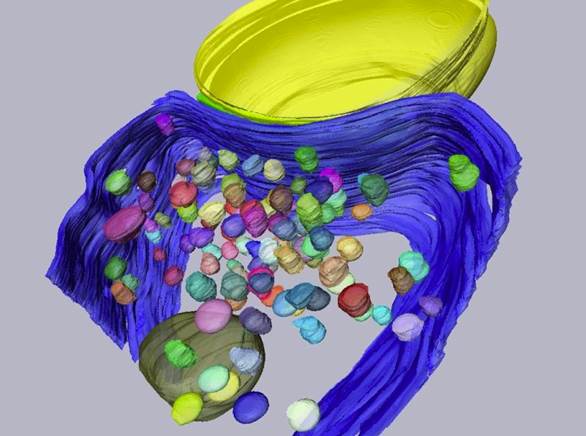A docking site per calcium channel cluster

Docking site (c) by Walter Kaufmann and Ryuichi Shigemoto
A study co-led by Ryuichi Shigemoto, Professor at the Institute of Science and Technology Austria (IST Austria), with Alain Marty, Professor at Université Paris Descartes, uncovers that a single docking site may use a single cluster of calcium channels and that both the number of docking sites and the number of calcium clusters change in parallel with brain age.
This establishes the first clear link between the morphology and function of docking sites. The study was published today in PNAS.
At a chemical synapse, signal transmission requires an elaborate sequence of events. It starts when an electrical signal, the action potential, reaches the synaptic terminal of the presynaptic neuron. This causes voltage-gated calcium channel to open. Calcium ions rapidly stream into the presynaptic terminal and the calcium concentration in the presynaptic terminal rises. This allows synaptic vesicles filled with neurotransmitter to fuse with the plasma membrane and release the neurotransmitters into the synaptic cleft. Speed is essential in information transmission.
Therefore, before the action potential even arrives at the presynaptic terminal, vesicles containing neurotransmitter line up in a fusion-ready state at docking sites in the presynaptic terminal. When the action potential reaches the presynaptic terminal, the vesicles can rapidly fuse and release the neurotransmitter.
Functionally, docking sites limit the maximum number of vesicles that can be released at each action potential, this determines the strength of the synapse. Until now, a clear link between the functional aspect of docking sites and their morphological aspect as sites where vesicles dock could not be established in the mammalian brain.
Shigemoto and colleagues used a high-resolution electron microscopy technique to look closely at the presynaptic terminal of a particular synapse in the mouse. They found that the number of functional docking sites matches the number of clusters of voltage-gated calcium channels in the presynaptic terminal.
In addition, the number of docking sites and the number of calcium clusters change in parallel with brain age and synaptic size. This led the researchers to a major conclusion, as Shigemoto explains: “Based on our results, we suggest that for each docking site, there is a corresponding cluster of voltage-gated calcium channels. We propose a model in which each cluster of calcium channels is surrounded by enough free space to allow one synaptic vesicle to fuse in any direction.”
Ryuichi Shigemoto joined IST Austria as Professor in 2013. He and his group investigate the functional roles of ion channels and neurotransmitter receptors in neurons and glia using morphological, electrophysiological and molecular biological techniques. Shigemoto received an ERC Advanced Grant in 2016. Walter Kaufmann, Staff Scientist in IST Austria’s Electron Microscopy Facility, performed part of the research for the current study.
http://www.pnas.org/content/early/2017/06/07/1704470114.full
http://ist.ac.at/fileadmin/user_upload/pictures/Press_pictures/170612_Shigemoto_…
Media Contact
All latest news from the category: Life Sciences and Chemistry
Articles and reports from the Life Sciences and chemistry area deal with applied and basic research into modern biology, chemistry and human medicine.
Valuable information can be found on a range of life sciences fields including bacteriology, biochemistry, bionics, bioinformatics, biophysics, biotechnology, genetics, geobotany, human biology, marine biology, microbiology, molecular biology, cellular biology, zoology, bioinorganic chemistry, microchemistry and environmental chemistry.
Newest articles

NASA: Mystery of life’s handedness deepens
The mystery of why life uses molecules with specific orientations has deepened with a NASA-funded discovery that RNA — a key molecule thought to have potentially held the instructions for…

What are the effects of historic lithium mining on water quality?
Study reveals low levels of common contaminants but high levels of other elements in waters associated with an abandoned lithium mine. Lithium ore and mining waste from a historic lithium…

Quantum-inspired design boosts efficiency of heat-to-electricity conversion
Rice engineers take unconventional route to improving thermophotovoltaic systems. Researchers at Rice University have found a new way to improve a key element of thermophotovoltaic (TPV) systems, which convert heat…



